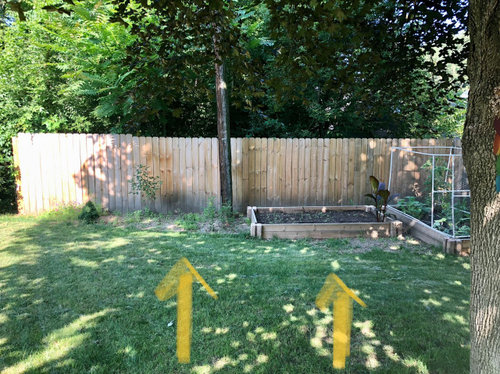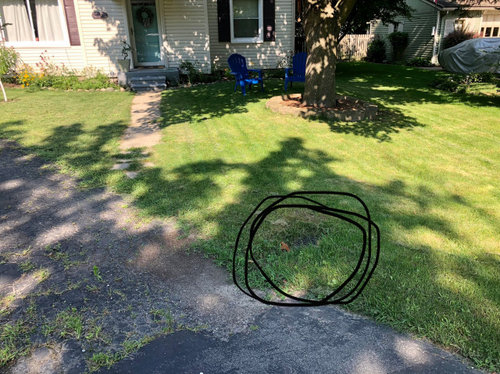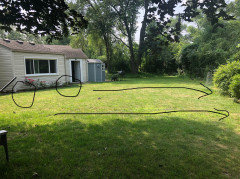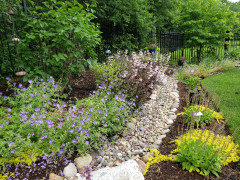Rain Garden(s) on Shady Lane
Hello! My partner and I moved to Ann Arbor in October 2020. We've put in three native beds and I'm now turning my gaze to potentially building a rain garden (or two). I've taken a few photos of potential spots where a rain garden could go. We will likely be building a patio next year, and to do so, they might need to take the spout and dig a spot underground for it to run off. This might be a great opportunity to tell the building to run the spout to a rain garden! I've included a few photos of spots in our front and/or backyard that might have potential to be a rain garden bed.

This is the South part of our back lawn (this part is West facing). Here you can see there's a gutter (this is the garage roof run-off). It could be directed west facing (it's now NNW facing) down to a bed. As you can see there's a lot of virginia creeper and buckthorn on the other side of the fence (an unkept vacant house lot is on the other side, a lot of fighting back on our side of the fence). As our house is East/West facing and 1,000 sq ft we get a fair amount of sun. In this area, it's a mix of shade and sun. Especially as a few trees just outside out lot provide good cover. The bed is nearly 40' from the downspout but as I said, with the patio being put in, we might have the downspout put underground and would run off to the bed.

Another possibility is on the North side of the back lawn. As you can see there is a lovely old maple providing cover. In the right part of this image is a native bed. The downspout is circled. This part of the yard actually slopes downward. See below.

This bed is a complete mix of stuff! Some native plants, some wildflowers, a peony, you name it! Again, some of the virginia creeper, well, creeps, under the fence and we have to rip it out. As you can see, there are two raised beds. One is empty at the moment (save for a canna lilly) and then there is a covered little vegetable garden. From an engineering standpoint (I'm not an engineer) because it slopes down this way, a rain garden would sort of be perfect here I think. But, we also have the beds. So I'm a bit unsure if this is where I would want it to go. The bed is somewhere between 30-40' from the downspout. Alternatively, I thought this particular downspout would be great for a rain barrel if I don't put a rain garden here.

This is the front of our house. The arrows indicate (and maybe you can see it) our lawn slopes down from the road. Our street is VERY quiet. Hardly any traffic. A2 has been getting a lot of rain this summer. Just to the left of the arrows, on the driveway you'll see a sewer plate. Below, you'll see another grate that's in the lawn, just off the driveway that leads to the sewer.


So, my thinking here is that potentially, two rain garden beds could be off the driveway/street. I'd move the hydrangeas. Up the driveway, there's a redbud. Unfortunately, the front yard of our house has a strange triangular lot so I'd have to get creative with the shape. The potential bed in the upper left space is about 15 feet from the spout (it's the beige L shape, you might see it, just passed the redbud).
I look forward to thoughts on these potential beds as rain gardens!
Comments (10)
Susan Bryan
2 years agopinkmountain has a good point about the Maple. Hard digging, and you don't want to mess with its health. She has good insight about the species too. So that might be a second choice, or you might strategize about staying away from the roots.
I agree that the back yard bed seems like an easy choice.
The front is interesting. Does the water flow down the driveway towards your house? How close does it get? With all of our big rains lately, it seems like you will know the answers! Along the driveway would work well, with some caveats. Sometimes you need to have the adjacent lawn open so if you or guests are stepping out of cars, you need that space. But if this isn't a spot that anyone ever parks, it could be a good location. And it could solve a problem, which is always nice.Susan Bryan
2 years agoHere is another Master Rain Gardener's "by the driveway" garden. She made sure the water already flowed towards this spot. (There is no changing the driveway!) Then, notice the edge of stones. That helped the water get into the rain garden, which she dug deeper than the driveway.
Ryan in A2
Original Author2 years agoThanks, Susan. There is run-off from the road. If I were to do it in the front/on the driveway, I could do stones away from the road/driveway to keep the water in. The bed you show on Facebook is lovely.
Ryan in A2
Original Author2 years agoThank you, Susan and pink mountain, for comments on the backyard. I’ll try to figure out what maple it is. It’s leaves are a deep burgundy and it turns a lovely red then yellow in the fall. We actually have two as you can see - one in the front and one in the back.
Ryan in A2
Original Author2 years agoLet's try this again! I've reevaluated where I'm going to put my rain garden. We will be installing a patio in spring 2022 (hopefully!) and the contractor said that they would have to redirect the downspout run off toward the back of the property. This is the perfect opportunity to use those impending PVC pipes to direct them to a rain garden bed. Please see the photo below. As you'll see, the back of the yard slopes downward ~20' from the house. Currently there are two forsythia bushes there which will be moved and then there is a chain link fence (we'll of course ensure the rain garden is 2' from the fence :)). I'm sure it won't be easy to move the bushes...ahh well.

Susan Bryan
2 years agoYou could conceivably leave the Forsythia there, if you like. Put the rain garden in on the near side of them. But only if you have enough room. :)
This is great! You can dig the rain garden now, since the patio building probably won't be trampling over it when they do that next year. The rain garden won't be in their walking-path, so that is nice.Susan Bryan
2 years agoYour only job when you build this rain garden is to make sure that the rain garden bottom is at least 4 inches *deeper* than the pipe. Use this calculation: The ~20' of pipe has to slope downward, so that the water makes it to the rain garden. So figure out how much that pipe needs to drop. Here is a quick calculator that calculates the *bare minimum* of drop your pipe needs to have. For safety, I would double it.
https://www.builderscalculator.com/drain-pipe-slope-calculator/
For your 20 feet of length, I get 2.5 inches of pipe drop. Double that, and you get 5 inches. Plus the depth of the rain garden (4 inches) and you get your digging depth: 9 inches. If you want to live dangerously, you could dig a bit less - but No Shallower Than 6.5 inches!
This is measured from where you think the bottom of the pipe will be once they build the patio. This might be pretty deep. At least 8 inches deep.
So that gives you a total of 9+8=17 inches deeper than your ground level near the house. How to measure that where the rain garden is? Put up your stakes with a string between. String it where the pipe will start and finish - ground level near the house, and level it with a line level. Then measure down 17 inches from the string where you will be building your rain garden. It can be this deep, OR DEEPER. Deeper is fine. It just can't be any shallower than this.
And since the ground slopes away from your house already, you won't have to dig the whole 17 inches. It will be less than that.
All that sounds do-able - don't you think? :)kimjapinga
2 years agoI’m excited to see the results of this project. A rain garden in that spot will be so pretty.
Van Zelst Inc
2 years agoThis discussion made us think of offering a link to our blog about rain gardens: https://www.vanzelst.com/blog/rain-gardens/. It includes a list of plant suggestions for the Midwest and some inspirational photos - Enjoy!
Another really helpful blog post about drainage problems and how to resolve them: https://www.vanzelst.com/blog/water-problems-and-solutions/.
Drainage issues resolved beautifully!
See more photos on our website Photo Gallery.
l pinkmountain